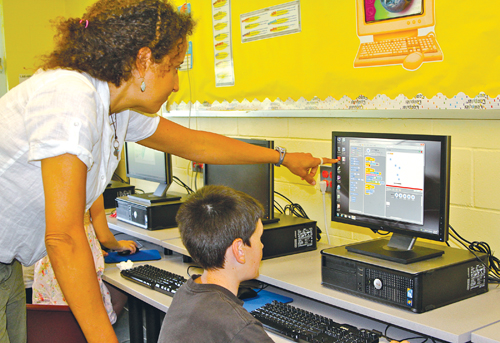Students at Oysterponds School learn to create video games

In a computer classroom at Oysterponds elementary school, 10-year-old Mack Mezynieski isn’t playing video games, he’s creating them.
Mack is enrolled in the school’s science, technology, engineering and math club known as STEM, where the students are also producing interactive stories, animations, music and art through a program called Scratch that was developed by the Massachusetts Institute of Technology.
Mack uses a mathematical formula to make a character jump on a trampoline.
“At first, I could only do one turn,” Mack said about his game. “I added more moves by using math and now I can flip.”
The Scratch program is just one of several new elements added to STEM.
Principal Francoise Wittenburg said the school enhanced its STEM program this year to nurture students’ inquisitive minds.
“Kids are so curious and we wanted to build on that,” Ms. Wittenburg said. “The kids were given challenges and they designed their own solutions.”
Earlier this year, kindergartners engineered an obstacle course in the gym. Students also took apart computers and learned about the “mother board,” the central component. During the school’s upcoming summer program, students will learn how to build machines by using Legos. Ms. Wittenburg described the curriculum as “the foundation of high school robotics.”
The kids are also applying STEM principals to the outside world.
Oysterponds is a member of the East End Edible School Garden group, a team of local educators creating a network of gardens at local schools.
Through the program, students used each component of STEM to create a vegetable garden.
Tom Stevenson from Oysterponds Farm taught students the science behind growing vegetables. Students used technology by researching different seedlings on the Internet. They also used math to engineer vegetable beds.
This year, students grew komatsu (a Japanese vegetable), chard, garlic, cucumber, tomatoes, basil and kale. After the harvest Friday, students made kale chips.
The school has held a pasta dinner and a talent show to raise funds to pay for a fence to keep the deer out. The community has also gotten involved by donating gardening materials.
STEM was also featured in the school’s “Water, Water Everywhere” science fair, where some student projects were about alternative wastewater systems. In those projects, students showed how plants naturally filter nitrogen.
Ms. Wittenburg said she’s looking forward to building on STEM’s success and believes it will become a model for other districts.
“We’re really trying to expose kids to real world issues in science because they are going to be the ones solving these problems for us,” she said. “This is definitely a great beginning. I’m excited to see what our teachers and students come up with next.”








